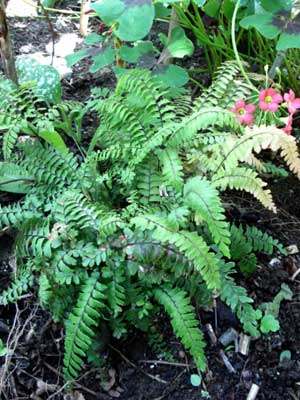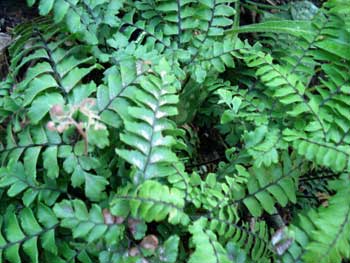
Rosy Maidenhair Fern
aka, Rough Maidenhair
"Slow, and pausing here and there
For a flower, or a fern,
For the lovely maidenhair;
Hearing voices in the air,
Calling faintly down the burn."
-Kate Seymore Maclean,
Toronto, 1880
Often used as an indoor fern due to hardiness (so long as it is never completely dry at the base), the Rosy Maidenhair Fern (Adiantum hispidulum, synonymous with A. pubescens) does best in a temperate garden.Toronto, 1880
It's deciduous in zones 7-8. In zone 9, in a cool shaded spot, it will be semi-evergreen. In zone 6 it has a better chance as a houseplant, but can survive in the garden with protection in winter, such as two inches of mulching with leaves or compost to be brushed aside mid-spring when it's ready to reappear. A. aleuticum would be a better choice for places with cold winters, as it won't need winter mulching..
 It can survive occasional drying out but surviving isn't the same as looking good. It should be kept moist to look its best.
It can survive occasional drying out but surviving isn't the same as looking good. It should be kept moist to look its best.In our garden it is more compact than our native Western maidenhair (A. aleuticum) & is a paler green without the black stems. It's a darker green, however, than the Northern maidenhair (A. pedatum), the ones I've seen at any rate. Such widespread ferns have considerable variation over their range, but the Rosy Maidenhair in mass-production generally has less of a sweeping flourish than our natives, with denser foliage.
Our naturally acidic soils seem to suit it perfectly well, though it will also thrive in more alkaline conditions so long as there is plenty of organic material in the soil.
For the first couple years it'll likely be under one-foot tall. When well established it'll approach two feet of looser finer foliage. The clump will broaden over time, to a foot's width.
Generally it will also "hump" upward, which isn't as attractive & can expose the fern to dryness causing brown bits or spotting. In such cases it should be divided spring or autumn for three into three or four plants then replanted back to the original crown's height.
It's called "Rosy" maidenhair because its new leaves will have a pinkish glow, then turn green, then develop a brassy or hue in autumn, preparatory for turning brown at winter. The color is not particularly striking however, & a green fern should be expected.
There'll be more strikingly pinkish young fronds if grown in a sunnier location, but in such a location it will be at risk of sun damage & drying out, so it takes a balancing act to maximize possibility of bronze or pink but minimizing how often it would need to be watered, taking much less in deeper shade.
Native to an enormous range from New Zealand, Australia, most Pacific islands, Southeast Asia, to China & deep into Africa, in a variety of climates but invariably moist environments.
It has naturalized a little invasively in some of the southern states where it seems likely to be a threat to the native variety, but to date has not been reported to escape from gardens here in the Northwest, & is not as perfectly suited as our elegant native species to what can be surprisingly dry summers on Puget Sound.